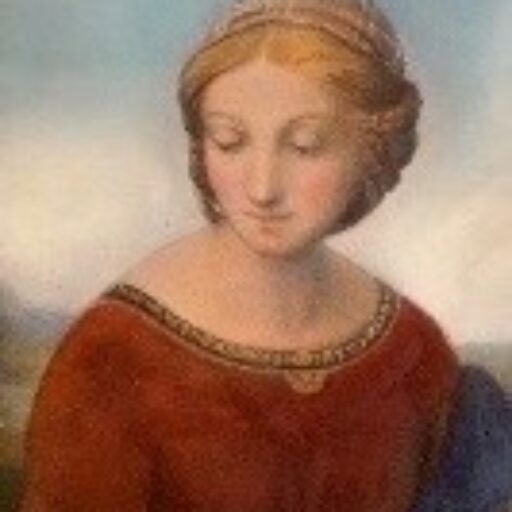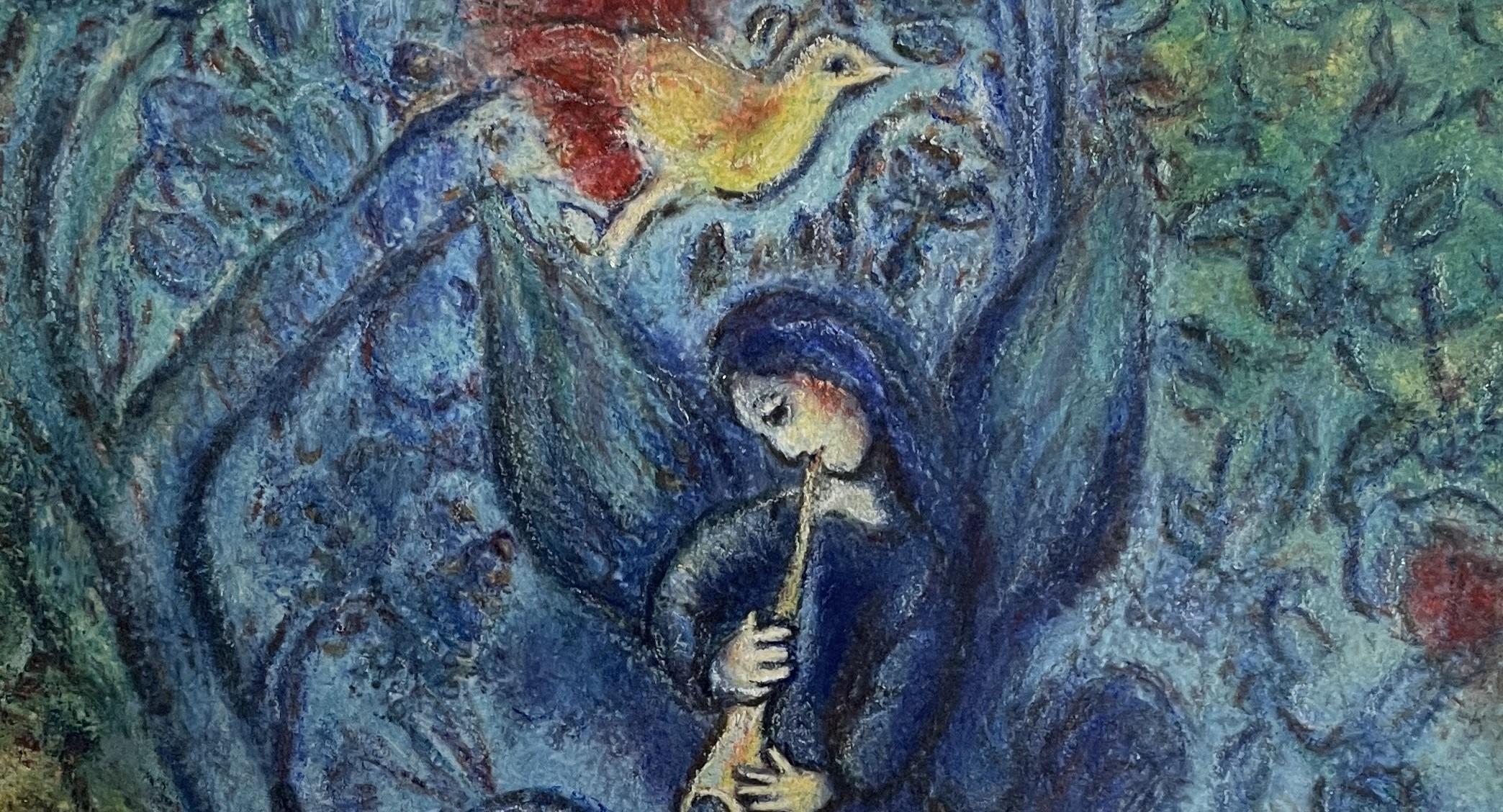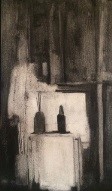日本語-Englishー台灣華語
ニコラ・ド・スタール「画家のアトリエ」
ピカソはド・スタールが描いた素晴らしい青い絵を持っていた。バルティスの若き日のこれまた魅力的な絵も持っていた。いずれも今はフランスのピカソ美術館にある。ピカソこそ女性と絵に関しては目利きなのだ。そのピカソが認めていたド・スタールは、何に行きづまったのか。ド・スタールは1914年に帝政ロシアの名門貴族の家系に生まれている。その後家族と一緒にポーランドに亡命するが、幼くして父母を亡くし、文字通り天涯孤独の故郷喪失者になってしまう。
ド・スタールは段階を経て抽象に達したわけではない。彼は自由な表現を模索し、一挙に抽象へと向かった。その契機となったのが最愛の恋人ジャニーヌの死である。ド・スタールは回想している。「若い頃、何年にもわたってジャニーヌの肖像を描いていた。肖像画、それも真実の肖像画を。それは芸術の一つの頂点である」と。抽象以前の作品は後年ド・スタールの手によってすべて破棄されてしまうが、ジャニーヌの肖像画だけは残されている。その絵はエル・グレコのようにほっそりとして魅力的だ。ド・スタールは対象を眼に見える通りに描くことに居心地の悪さを覚え、抽象を目指す。ド・スタールは抽象画と具象画を対比させては考えない。ある一枚の絵が同時に抽象でも具象でもあり得ると考える。ド・スタールは両者が別々のものと考えられていた時代に二つを融合しようとしたのである。ド・スタールは、絵画は壁という意味で抽象であり、空間の表現という意味で具象的であると述べている。こうして彼は絵画を壊し始める。主題の輪郭を、対象を形作る線を、執拗に打ち砕く。鏝やナイフといった職人が使う道具で、セメントを思わせるグレーの絵の具を厚く塗り込める。あえて描き方を限定することで生じる困難にこだわる。フォルムのバリエーションはおのずと少なくなり、余分なものは極限までそぎ落とす。ド・スタールはイーゼルや椅子といったアトリエの中にある日用品を描く。港の光景、往来する船、澄み渡る空と海、そこに舞うかもめなど、アトリエの窓から見える景色を描く。そして重く分厚いマチエールの完全抽象だった作品に、少しずつ具体的な形が現れ始める。以後彼の作風は明るい半具象の薄塗りに傾いて行く。1950年代に入るとド・スタールは次第に認められ、経済状況は好転する。しかし1955年に展覧会を目前にしてアトリエの窓から身を投げてしまう。
ド・スタールの絵は驚く程大きく、絵の具も厚い。これだけ大きな絵を描いて巧くいかないとなると挫折感は大きいに違いない。私は小さな紙に黒い鉛筆一色でド・スタールのアトリエの風景を描いてみることにした。ド・スタールの絵はもちろん油絵で大きい。鉛筆だけで描いたのではド・スタールの絵に似せるのは難しい。だんだんやけになって雑に描き殴る。するとそれまで巧くいかなかったド・スタールの絵は、にわかによくなる。ド・スタールは荒れていたのだ。画家のアトリエを描いたこの絵は、苦悩の中でもがき、自分の画家としての力量に戸惑う自画像なのかもしれない。アトリエの風景をモチーフにしたのは、行き詰まった自分を打破したかったからに違いない。
ド・スタールには、ゴッホに似た何かがある。全てを賭けた作品には情熱が滲み出ている。亡くなるまでの二ヶ月間、恐ろしいペースで制作に没頭し、九十枚の絵を描き上げている。自信と躊躇の波が繰り返し襲って来たに違いない。パリで現代音楽のコンサートを聴いた直後にアトリエに戻り、3.5m×6mの巨大なキャンバスに向かう。これほど大きな絵に取り組むのは初めてのことだった。網膜に焼き付く赤。ピアノの強い黒。軽やかな音楽を奏でそうな未完の作品 「コンサート」は、今観ると一つの頂点を極めた傑作である。だれよりもド・スタールは、もはやこれ以上描くことができない自分に気づいたのかもしれない。ド・スタールの絵は今ではとても高価だ。
Atelier of Artist
Picasso had a wonderful blue painting by de Staël. He also had a charming painting from the younger days of Balthus. Both are now in the Picasso Museum in France. Picasso was indeed a connoisseur when it came to women and paintings. What led de Staël, who was acknowledged by Picasso, to his end? De Staël was born in 1914 into a distinguished noble family of Imperial Russia. Later, he and his family sought asylum in Poland, but he lost his parents at a young age, becoming a literal orphan and a lost soul of his homeland.
De Staël did not reach abstraction through stages. He sought free expression and moved directly towards abstraction, triggered by the death of his beloved lover Janine. De Staël recalled, “When I was young, I painted Janine’s portrait for many years. A portrait, and moreover, a true portrait, is one of the pinnacles of art.” Although his pre-abstract works were all destroyed by de Staël in later years, only the portraits of Janine were preserved, slender and charming like those of El Greco. De Staël felt uncomfortable depicting objects as they appear to the eye, aiming instead for abstraction. He did not contrast abstract and figurative painting but believed that a single painting could be both simultaneously. De Staël sought to fuse the two during a time when they were considered separate. He stated that painting is abstract in the sense of being a wall and figurative in expressing space. Thus, he began to destroy painting, relentlessly smashing the contours of subjects, the lines that form objects. He used tools like trowels and knives to thickly apply cement-like grey paint, embracing the difficulties that arise from deliberately limiting his painting methods. The variation in forms naturally diminished, stripping away anything superfluous. De Staël painted everyday items found in his studio, such as easels and chairs, as well as scenes visible from his studio window, like the harbor, passing ships, clear skies and seas, and seagulls. Gradually, concrete forms began to emerge in his previously completely abstract works with heavy texture. From then on, his style shifted towards a lighter, semi-abstract thin painting. By the 1950s, de Staël gained recognition, and his financial situation improved. However, in 1955, just before an exhibition, he jumped out of his studio window.
De Staël’s paintings are surprisingly large, and the paint is thick. The frustration of not succeeding with such large paintings must have been significant. I decided to sketch the landscape of de Staël’s studio on a small piece of paper with just a black pencil. De Staël’s paintings are, of course, large oil paintings. It’s difficult to mimic de Staël’s paintings with just a pencil. As I became increasingly frustrated, my sketches became rough and hasty, but suddenly, de Staël’s previously unsuccessful paintings began to improve. De Staël was in turmoil. This painting of the artist’s studio may be a self-portrait, depicting his struggle and confusion about his own abilities as a painter. The motif of the studio landscape was chosen to break through his own impasse.
De Staël had something similar to van Gogh. His all-in works ooze passion. For the last two months of his life, he immersed himself in painting at a terrifying pace, completing ninety paintings. He must have been repeatedly hit by waves of confidence and hesitation. After attending a contemporary music concert in Paris, he returned to his studio and faced a huge canvas of 3.5m x 6m. It was his first time tackling such a large painting. The red that seared into his retina. The strong black of the piano. The unfinished piece “Concert,” which seems to play light music, is now considered a masterpiece, a pinnacle of achievement. Perhaps de Staël realized that he could no longer paint more than anyone else. De Staël’s paintings are now very expensive.
尼古拉·德·斯塔爾《畫家的工作室》
畢卡索擁有德·斯塔爾繪製的一幅絕妙的藍色畫作。他也擁有巴爾蒂斯年輕時期迷人的畫作。這些現在都在法國的畢卡索美術館。畢卡索確實是對女性和畫作有眼光的人。那麼,被畢卡索認可的德·斯塔爾遇到了什麼困難呢?德·斯塔爾1914年出生於帝政俄羅斯的名門貴族家庭。後來與家人一起流亡到波蘭,但年幼時失去了父母,成為了字面上的孤兒和失去故鄉的人。
德·斯塔爾並非逐步進入抽象藝術。他尋求自由的表達方式,一躍而入抽象藝術。成為轉折點的是他最愛的戀人珍妮的逝世。德·斯塔爾回憶說:“年輕時,我畫了好幾年珍妮的肖像,一個真實的肖像畫。那是藝術的一個高峰。”抽象之前的作品後來都被德·斯塔爾銷毀,只有珍妮的肖像畫留下。那幅畫像埃爾·格列柯一樣纖細迷人。德·斯塔爾對於按照眼前所見來繪畫感到不適,轉而追求抽象。德·斯塔爾不將抽象畫和具象畫對立起來。他認為一幅畫同時可以是抽象的也可以是具象的。德·斯塔爾試圖在被認為是分開的時代融合這兩者。他說,畫作在意味著牆壁的抽象性和在表達空間的具象性方面。因此,他開始打破畫作的傳統,執著地破壞主題的輪廓,用工匠的工具如抹子或刀,在畫布上厚厚地塗抹像水泥一樣的灰色顏料。他堅持通過限制繪畫方式來面對挑戰。形式的變化自然變得有限,多餘的部分被極限削減。德·斯塔爾畫了工作室裡的日常用品,如畫架和椅子。他還畫了從工作室窗戶看出去的景色:港口、來往的船隻、清澈的天空和海洋,以及飛舞的海鷗。隨後,在完全抽象的厚重質感作品中,逐漸浮現出具體的形狀。此後,他的作風逐漸轉向明亮的半具象薄塗。進入1950年代,德·斯塔爾逐漸獲得認可,經濟狀況好轉。然而,在1955年展覽會前夕,他從工作室的窗戶跳下自盡。
德·斯塔爾的畫作驚人地大,顏料也厚重。這樣大的畫作若遇到困難,挫折感無疑非常大。我決定用黑色鉛筆在小紙上畫德·斯塔爾的工作室風景。德·斯塔爾的畫當然是大型油畫。只用鉛筆畫難以模仿德·斯塔爾的風格。畫得越來越隨意,越來越粗糙。然而,就在這時,之前畫不好的德·斯塔爾畫作突然變得好了。德·斯塔爾畫作中的狂暴。這幅畫可能是在苦難中掙扎、對自己作為畫家能力的困惑中的自畫像。選擇工作室風景作為主題,是因為想要打破自己的僵局。
德·斯塔爾有著類似梵高的某種特質。他那些全力以赴的作品中滲透著激情。在去世前兩個月,他以驚人的速度投入創作,完成了九十幅畫作。他一定經歷了自信與猶豫的反覆折磨。在巴黎聽完一場現代音樂會後回到工作室,面對一幅3.5米×6米的巨型畫布。這是他首次嘗試這麼大的畫作。網膜上烙印的紅色、鋼琴的強烈黑色。這些未完成的作品《音樂會》,現在看來,達到了一個高峰,是一件杰作。或許德·斯塔爾意識到了自己再也無法創作出更好的作品。德·斯塔爾的畫作如今價值連城。



